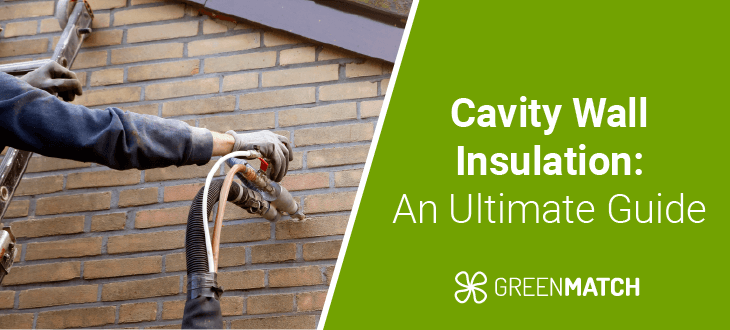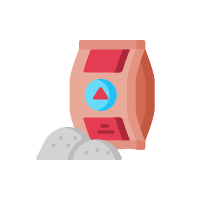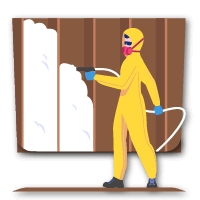Answer these simple questions and we will find you the BEST prices
Which type of solar quotes do you need?
It only takes 30 seconds
100% free with no obligation

Get Free quotes from insulation specialists near you

Save money by comparing quotes and choosing the most competitive offer

The service is 100% free and with no obligation
- GreenMatch
- Insulation
- Wall Insulation
- Cavity Wall Insulation
Cavity Wall Insulation: A Comprehensive Guide


- Uninsulated walls cause up to 33% of all heat loss in a home.
- The cost of cavity wall insulation for a typical 3-bedroom semi-detached house in the UK is around £2700.
- Cavity wall insulation can save you up to £235 annually in a semi-detached UK house.
Cavity walls make up nearly three-quarters of all UK properties, but according to the Department for Energy Security & Net Zero, 29% of these properties have no form of insulation. This adds to about 6.1 million homes, reflected in the UK’s soaring energy bills and housing stock carbon footprint.
Cavity wall insulation is one of the most cost-effective and long-lasting energy efficiency upgrades any home could carry out, bringing about massive energy bill savings and reductions in domestic CO2 emissions of up to 0.7 tonnes per year!
If you’re wondering; what is cavity wall insulation? This ultimate guide by GreenMatch UK is for you. Read on for all the knowledge you need, including process, best materials, costs, savings, and grants. This way, you can make an informed decision on the best approach for your home.
Ready to insulate your walls? Save yourself from the headache of endless research and vetting by working with GreenMatch UK! Instead of spending countless hours surfing the web, just spend 30 seconds filling out our online form, and we’ll send you 3 free home-tailored quotes from trusted installers in your area. The best part? There are no fees or obligations, just sit back and let the bargains come to you. Click below to begin!
- Describe your needs
- Get free quotes
- Choose the best offer
It only takes 30 seconds



What is cavity wall insulation?
To explain cavity wall insulation, we first need to understand what properties make a cavity wall unique. Unlike solid walls, cavity walls are made up of two walls; a brick outer wall and a concrete inner wall with a ‘cavity’ space in between.
Usually, it’s required for the cavity space to be at least 50mm to house insulation, but older properties might have up to 100mm cavity wall insulation in place, with rare occurrences of even 150mm cavity wall insulation in some homes.

You can usually identify a cavity wall by looking at the brickwork pattern of your property. If the bricks of your home are evenly laid, lengthways and symmetrical, you likely have cavity walls.
Cavity wall insulation costs around £2700 for a 3-bedroom semi-detached UK home. The process involves injecting insulation material into the cavity space through holes drilled in the outer wall. This can only be handled by a professional installer, but is a quick, non-invasive and mess-free process that leaves no changes to your home's facade.
How do you insulate a cavity wall?
Insulating a cavity wall is a quick, mess-free and efficient process that only takes 1-2 hours at most, but brings about home improvements that you will enjoy for decades to come. However, the insulation process cannot be done DIY, and a professional installer is required.
This is because insulating a cavity wall requires specialist equipment, and complex wall preparation if there is any mould, dampness or structural damage in place. Here’s what cavity wall insulation installation looks like:
- Preparation: An accredited installer first inspects your walls to make sure they’re in the right condition for insulation. Any wall dampness, dampness on existing cavity insulation or wall damage must be addressed before injecting insulation. The cavity space must be at least 50mm wide, and any existing wires in the cavity will need relocating to avoid fire hazards.
- Accessing the cavity: Once the walls are checked and prepared, the installer begins by drilling small holes about 25mm wide through the outer brick walls, each about a metre apart. This is to access the inner cavity space from the outside of the property, a non-invasive and mess-free approach to injecting insulation.
- Injecting insulation: Then, a special applicator hose is used to inject insulation material into the cavity space. Normally, mineral fibre, polystyrene beads, or expanding spray foam insulation is used for this job. For retrofit cavity wall insulation jobs, this is usually done with drill holes
- Sealing up: After the insulation material has been injected into the cavity space, the installer seals the holes with cement mix, leaving your home's outer facade intact.
Cavity wall insulation is perhaps the most non-invasive, quick and easy approach to wall insulation, making it well worth the investment and effort.
Common cavity wall insulation problems
Like any insulation job, poor workmanship leads to insulation problems. A faulty installation can lead to mounting repair costs down the line, becoming a greater financial headache than the initial installation in the first place.
Common causes of cavity wall insulation problems are water penetration from poor sealing, outdated insulation materials, or insulating damaged walls that aren’t suitable for the job in the first place. Here are some of the key causes and problems of poor cavity wall insulation:
- Poor workmanship: Poor sealing of the drilled holes, insufficient insulation material, or damaged brickwork can expose your cavity space to moisture buildup. This inevitably causes mould growth, damage and compression to your insulation material, reducing its effectiveness and resulting in hefty removal and replacement costs.
- Insufficient ventilation: Cavity walls must have a gap of at least 50mm or more to adequately house insulation material without compromising ventilation space. A healthy airflow is key to making sure your insulation doesn't build up moisture and rot, doing your property and savings more harm than good.
- Outdated insulation material: Most homes with existing cavity wall insulation likely use formaldehyde foam or EPS beads. While popular in the 1900s, these insulation materials are now considered outdated and ineffective. Much more effective and robust alternatives exist today, such as mineral fibre, polystyrene beads, or spray foam.
- Damaged cavity walls: Walls with damaged brickwork, internal dampness, mould, or previous shabby insulation that needs removing require solving these issues before considering new insulation. Organisations like the Property Case Association (PCA) can conduct an assessment of your cavity walls to identify issues and solve them.
To avoid such problems from occurring, it's important to work with a professional cavity wall insulation installer who is certified by the Cavity Insulation Guarantee Agency (CIGA) or a similar accreditation that ensures professionalism.
Best materials to insulate cavity walls in comparison
The best cavity wall insulation will depend on your circumstances, such as budget, eco-consciousness, and home type. The three best cavity wall insulation types are mineral fibre, polystyrene beads, and spray foam insulation. Each comes with its set of pros and cons worth considering.

Mineral fibre is an affordable cavity wall insulation material that became popular due to ease of production and has been a favourable choice amongst homeowners since. The material generally costs no more than £14 - £20 per m2 of cavity wall. It’s also one of the more sustainably produced options which can be recycled and reused.
The loose fibres are injected into the cavity space through specialist equipment but require to be airtight and sealed to avoid outside contact, as mineral fibre is notoriously difficult to maintain against moisture buildup and damage.
- Made from rock and glass, this material can be produced sustainably and even recycled many times over.
- Mineral fibre is much cheaper than other cavity wall insulation materials, generally costing around £14 – £20 per m2.
- Mineral fibre is the most susceptible to clumping and dampness issues, making it the most difficult material to maintain.
- Dampness and mould damage to the insulation can mount up to the need for cavity wall insulation removal, which is an expensive process.

Polystyrene beads, normally found in expanded (EPS) form, are polymer beads of around 0.5mm in diameter, which can expand up to 3 - 5 mm to fill the cavity space. They normally cost around £18 to £22 per m2. Like all cavity insulation, polystyrene beads are injected into the cavity space with specialist equipment.
While these may not be a natural product per se, their water resistance, great insulation performance, and endless recyclability still make them a sustainable and durable long-term solution for domestic wall insulation.
- Due to the low absorption rate of EPS polystyrene, moisture doesn’t penetrate or leech onto the beads, allowing the insulation to dry out even if in contact with dampness.
- EPS polystyrene has a high heat retention capacity, similar to rigid PUR boards and much higher than standard mineral fibre.
- EPS polystyrene can be recycled! Once removed, these beads are broken down into original components and made into other polymer products.
- EPS polystyrene bead insulation tends to cost more than mineral fibre.
- This type of insulation requires a completely cleaned cavity space. This can be an expensive procedure if you have old insulation or debris to remove from the cavity.

Cavity spray foam insulation is a foam-based substance that’s injected into cavity walls, where it expands to create an airtight insulation seal. Spray foam can be found made from two materials; polyurethane (PUR) foam and polyisocyanurate foam. Polyurethane insulation foam for cavity walls typically costs around £22 to £26 per m2.
While spray foam boasts some of the highest heat retention rates out of the options described, it is also the least sustainable and unrecyclable of the mentioned materials.
- With one of the highest heat retention rates, spray foam is very good at reducing domestic heat loss.
- Spray foam is far more mould-resistant than most other insulation materials.
- The expanding nature of spray foam creates an air barrier, effective at stopping hot air from leaving your home.
- Spray foam is unsustainable, unrecyclable, and can release toxic off-gases and volatile organic compounds (VOCs), potentially harming you and the planet.
- Spray foam can shrink over time, reducing its insulating properties and potentially making way for water damage to your inner cavity walls.
- The expanding nature of spray foam might increase insulation, but it compromises air ventilation in the cavity space, leading to dampness.
How much does it cost to insulate a cavity wall?
Wondering how much is cavity wall insulation? A cavity wall insulation cost for a typical 3 bedroom semi-detached UK home is around £2700 but brings an impressive £235 yearly return on energy bill savings. That way, your investment would have paid itself off in just over a decade.
Here is a full breakdown of expected cavity wall insulation costs per home type, and how much you can expect to save on your energy bills each year:
| Home type | Average costs (£) | Energy bill savings (£/year) |
|---|---|---|
| Flat / Apartment | £1000 | £110 |
| Mid terrace home | £1500 | £140 |
| Semi-detached home | £2700 | £235 |
| Detached bungalow | £2100 | £175 |
| Detached home | £4600 | £405 |
In any case, your final investment for cavity wall insulation can differ significantly based on your home size, wall condition, location, and choice of insulation materials.
It’s best to conduct a housing assessment with a professional insulation company to get the best picture of how much the job would cost you.
Grants to insulate your cavity walls for less or for free
To achieve net zero by 2050, the UK government has put much-needed focus on improving the energy efficiency of the housing stock. There are currently two cavity wall insulation grants in the UK through schemes that provide reduced cost and free cavity wall insulation; the Great British Insulation Scheme (GBIS), and the Energy Company Obligation (ECO4) Scheme.
Here’s how each scheme approaches insulation:
- The Great British Insulation Scheme (GBIS) provides one-off home upgrades to qualifying households, including cavity wall insulation, based on the results of a home inspection to identify the best measure. That way, the scheme prioritises its reach across the UK. The scheme can be applied directly from the UK government portal.
- The Energy Company Obligation (ECO4) Scheme functions differently from the GBIS as it places direct responsibility on energy providers to assist qualifying households with energy efficiency measures. The scheme covers a multitude of home upgrades, from boiler repairs to cavity wall insulation. You can apply by contacting your energy provider to learn more about the process.
Both schemes are active until March 2026, and provide a variation of domestic energy upgrade measures to fuel poor and energy inefficient homes throughout the UK.
Who is eligible for a cavity wall insulation grant?
For both the Great British Insulation Scheme (GBIS) and the Energy Company Obligation (ECO4) Scheme, there are a series of criteria that qualifying households and their residents must meet to receive free cavity wall insulation. Here are the main criteria to look out for:
- Low-income households: Both insulation grants typically prioritise households that are classed as low-income, to help alleviate fuel poverty and energy inefficiency in such households.
- Energy Performance Certificate (EPC) ratings: Homes with an EPC rating of D to G are strong candidates to qualify for both schemes. These homes are considered far less energy-efficient than the UK target for domestic housing stock.
- Council tax bands: Council tax bands determine how much council tax you pay, based on the value of your property. Households within the council tax bands A to D in England, and A to E in Scotland and Wales can qualify for free loft insulation.
- Government benefits: Households with residents who receive government benefits or allowances are likely eligible for insulation assistance.
More information can be found through the UK government portal regarding the Great British Insulation Scheme, or by contacting your energy provider for the ECO4 scheme.
Is cavity wall insulation worth it?

Cavity wall insulation is one of the most effective and rewarding home upgrades anyone could implement. It brings about a wealth of advantages, including financial savings, a well-maintained home environment, and a greener planet.
Here are just some of the benefits you can expect to enjoy with cavity wall insulation:
- Energy bill savings: Poorly insulated walls result in your heating system working overtime to try to make up for lost heat. Cavity wall insulation reduces the need for your heating system to constantly work, resulting in up to £405 in annual energy bill savings for detached UK homes!
- Reduced carbon footprint: UK housing is considered some of the most energy-inefficient in the European neighbourhood. Cavity wall insulation can significantly reduce heat loss in your home, and how often you need to heat it. This can lead to a staggering 1.1 tonnes of annual CO2 cuts in detached homes!
- Healthier home: Homes that are damp and drafty are breeding grounds for mould and rot. This can pose serious risks to your property through structural damage, but also to your health, as mould heightens the risk of respiratory illnesses and asthma.
- Better property value: By getting cavity wall insulation installed, you will be raising your home's Energy Performance Certificate (EPC) rating. This means your property will be valued much higher on the market should you ever rent or sell it.
Cavity wall insulation is a highly effective home insulation method that is sure to slash your energy bills, improve your home environment, and benefit the planet as well. However, finding the right professional installer can cost you endless hours of research and vetting. Luckily, GreenMatch UK is here to free you from the burden!
Gain exclusive access to our wide network of trusted professional installers throughout the UK by using our services. Simply fill in our quick 30-second form, and we’ll send you up to 3 free home-tailored quotes from accredited installers right in your area. Begin today and land yourself the best bargain!
- Describe your needs
- Get free quotes
- Choose the best offer
It only takes 30 seconds



FAQ
The greatest disadvantage of cavity wall insulation is likely that most insulation materials can lead to inadequate cavity ventilation. This is especially the case with spray foam insulation. Additionally, poorly installed cavity wall insulation can quickly become a financial headache to remove and replace.
Two main grants in the UK offer reduced cost or free cavity wall insulation for qualifying households. These are the Great British Insulation Scheme (GBIS) and the Energy Company Obligation (ECO4) Scheme, both active until March 2026.
Both schemes target fuel-poor and energy-inefficient households with insulation upgrades aimed at reducing domestic CO2 emissions and bolstering better heat retention.
If not installed correctly, cavity wall insulation can obstruct healthy airflow through the cavity space, leading to moisture and dampness buildup. A lack of ventilation can prevent the water buildup from drying out, resulting in mould and mildew growth. Polystyrene bead insulation is an effective solution to reducing your chances of this occurring.
The best insulation for cavity walls depends on your specific desires, but when balancing cost, effectiveness, and sustainability, polystyrene beads emerge as a great option for cavity wall insulation. They are easily installed, water and mould-resistant, and accommodate ventilation space for your cavity wall, thus reducing the risk of dampness buildup.

Akif is a copywriter at GreenMatch since 2023. With a keen interest in community sustainability, green solutions and the role of digital media in identifying climate trends, he aims to hone in on his background in International Studies and Digital Media to provide a multidisciplinary approach to written content rooted in credible research and accuracy.
We strive to connect our customers with the right product and supplier. Would you like to be part of GreenMatch?

